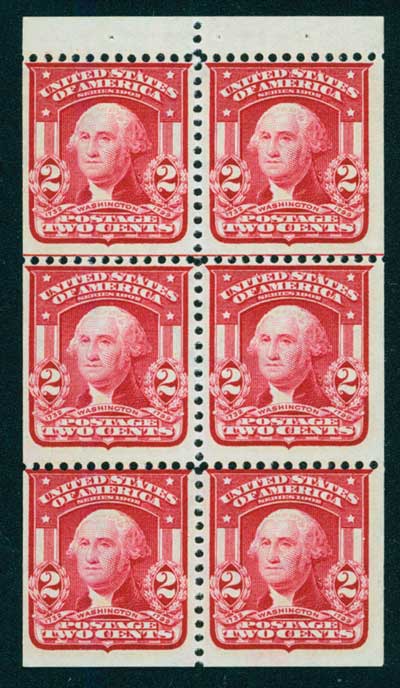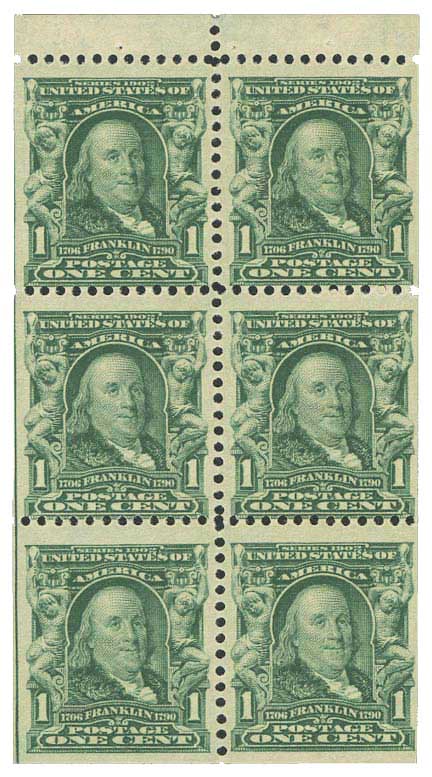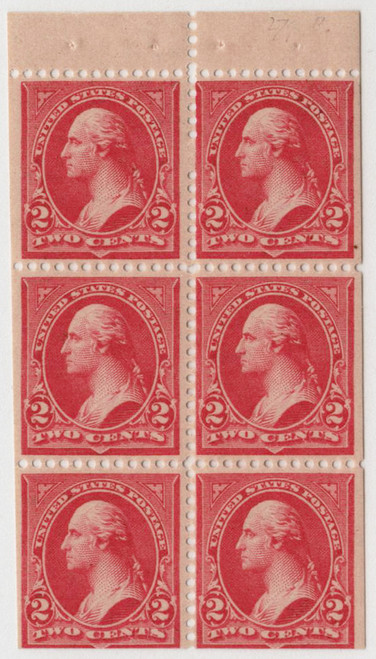
# 279Bj - 1900-03 2c red
Â
U.S. #279Bj
Series of 1898-99 2¢ Washington
Universal Postal Union Colors
Booklet Pane of 6
Earliest Known Use:Â May 4, 1900
Printed by:Â Bureau of Engraving and PrintingÂ
Watermark:Â Double line USPSÂ
Perforation:Â 12
Color:Â Red
This 2¢ Washington stamp paid the domestic letter rate. At the time U.S. #279B was current, the U.S. was still involved in the Spanish-American War and its aftermath. The U.S. had Military Stations in occupied Spanish Colonies. In April, 1898, the U.S. Postmaster General prohibited all mail between our country and Spain, including its colonies.Â
Two months later, he reversed his order to allow mail to and from service personnel serving in the Spanish colonies. To simplify matters, the three war regions were considered to be branches of selected Post Offices in the continental U.S. The Philippine war theater was handled as a branch of the San Francisco Post Office. Cuba was treated as a branch of the New York office, and Puerto Rico as part of the Washington, D.C. Post Office.
Postal customers who were actually service personnel – or closely connected to them – could send mail for the domestic rate of 2¢ per half ounce. Civilians were required to pay the international rate of 5¢ per half ounce.
Â
After the war ended, U.S. #279B was also overprinted for use in the Philippines, Puerto Rico and Cuba.
Why the Series of 1898-99 Was Produced
In 1863, Lincoln’s Postmaster General Montgomery Blair suggested an international conference be held to discuss common postal problems. A conference was held in Paris, and fifteen nations attempted to establish guidelines for an international postal service. Until this time, mail had been regulated by a number of different agreements that were binding only to signing members.
Although Blair did not intend to create a permanent organization, another conference was held 11 years later in Bern, Switzerland. Twenty-two nations, comprising the International Postal congress, drafted and signed the Bern Treaty, which established the General Postal Union. Under this treaty, member nations, including Europe, Britain, and the United States, standardized postal rates and units of weight. They also set forth procedures for transporting ordinary mail. Ordinary mail included letters, postcards, and small packages. Separate rules govern the transportation of items, such as parcel post, newspapers, magazines, and money orders.
Under this agreement, known as the International Postal Convention, a simpler accounting system was devised as well. Previously, countries could vary the international rate. Any mail traveling across a country’s border was charged this rate. In addition, many countries charged a 1¢ surtax for mail being transported by sea for more than 300 miles. Using the basic idea that every letter generates a reply, the Convention allowed each country to keep the postage it collected on international mail. However, that country would then reimburse other members for transporting mail across their borders. The benefits to member nations included lower postal rates, better service, and a more efficient accounting system.
In 1878, at the second conference, the name was changed to the Universal Postal Union (UPU). It wasn’t until the 1880s that the organization became truly universal. By the 1890s, nearly every nation had become a member. In 1947, the UPU became a specialized agency of the United Nations. Today, it continues to organize and improve postal service throughout the world. It’s the oldest international organization existing and claims to be the only one that really works.
In 1898, the Universal Postal Union standardized the colors of certain stamps in order to make international mailing easier and more efficient. They proposed that member nations use the same colors for stamps of the same value. In order to conform to the UPU’s regulations, the 1¢, 2¢, and 5¢ stamps underwent color changes. Later that same year, the 4¢, 6¢, 10¢, and 15¢ stamps were changed to avoid confusion with current issues printed in similar colors.
First U.S. Stamp Books
In 1884, a man named Albert W. Cooke of Boston received a patent for a “Book for Holding Stamps.â€Â Cooke’s design was for a small book that could fit in a vest pocket that had alternating pages of stamps and paper treated with wax “so that the gummed side of the stamps shall not stick to it under the action of heat or moisture.â€

It’s unknown whether or not Cooke shared his idea with the post office at the time, however it would be 16 years before they would adopt a similar idea. By early 1900, Captain P.C. Bane, a bookbinder at the Bureau of Engraving and Printing (BEP) had started creating stamp booklets for his personal use. He would place blocks of stamps in between pieces of cardboard and lunch paper for convenience. He thought it was a good idea, so he shared it with the director of the BEP.

The director agreed it was a good idea and in turn shared it with the post master general. The postmaster agreed as well, and on March 26, 1900, ordered that stamp books be prepared for public use. On April 18 (some sources say April 16), the first US stamp books were placed on sale for the public. The post office offered the books in three sizes. Each book only had 2¢ stamps, but customers could choose between 12, 24, and 48 stamps in a book. The books were sold at 1¢ over the face value (so the 12-stamp book sold for 25¢, etc.)
Each book contained sheets of six stamps with paraffined paper between them to prevent sticking. The cardboard covers had domestic and foreign postage rates printed on them, as well as information about the money order and registry systems. The books proved to be very popular with the general public and several post offices sold out of their supplies on the first day they were placed on sale. In the coming months, the post office quickly perfected their system for making the books and were able to produce 20,000 per day at a cost of $3.85 per thousand.

The stamps used for the first run of books were Scott #279Bj, the red 2¢ Washington from the Universal Postal Union Colors series. In January 1903, the booklets were made with the new ornate 2¢ Washington “flag†stamp, #301c. However, the regular #301 stamp had proven unpopular and was redesigned, with a shield replacing the flags that flanked Washington’s portrait, and the book stamp #319g was issued that December.

It would be a few more years before the books would be produced with another denomination. In 1907, the postmaster general reported that there had been increasing demand for 1¢ stamps due to the rising popularity of illustrated post cards. So they used the same book format that had been previously created for the 1¢ stamps.
In late 1908, the postmaster sought to create more appealing books. He thought the current covers were plain, so the new ones were imprinted with the post office department’s official seal. The back of the books showcased the model form of an address.
Stamp booklets continued to carry a 1¢ premium until 1963. They’re still in use today, proving popular and convenient for mailers.
Â
U.S. #279Bj
Series of 1898-99 2¢ Washington
Universal Postal Union Colors
Booklet Pane of 6
Earliest Known Use:Â May 4, 1900
Printed by:Â Bureau of Engraving and PrintingÂ
Watermark:Â Double line USPSÂ
Perforation:Â 12
Color:Â Red
This 2¢ Washington stamp paid the domestic letter rate. At the time U.S. #279B was current, the U.S. was still involved in the Spanish-American War and its aftermath. The U.S. had Military Stations in occupied Spanish Colonies. In April, 1898, the U.S. Postmaster General prohibited all mail between our country and Spain, including its colonies.Â
Two months later, he reversed his order to allow mail to and from service personnel serving in the Spanish colonies. To simplify matters, the three war regions were considered to be branches of selected Post Offices in the continental U.S. The Philippine war theater was handled as a branch of the San Francisco Post Office. Cuba was treated as a branch of the New York office, and Puerto Rico as part of the Washington, D.C. Post Office.
Postal customers who were actually service personnel – or closely connected to them – could send mail for the domestic rate of 2¢ per half ounce. Civilians were required to pay the international rate of 5¢ per half ounce.
Â
After the war ended, U.S. #279B was also overprinted for use in the Philippines, Puerto Rico and Cuba.
Why the Series of 1898-99 Was Produced
In 1863, Lincoln’s Postmaster General Montgomery Blair suggested an international conference be held to discuss common postal problems. A conference was held in Paris, and fifteen nations attempted to establish guidelines for an international postal service. Until this time, mail had been regulated by a number of different agreements that were binding only to signing members.
Although Blair did not intend to create a permanent organization, another conference was held 11 years later in Bern, Switzerland. Twenty-two nations, comprising the International Postal congress, drafted and signed the Bern Treaty, which established the General Postal Union. Under this treaty, member nations, including Europe, Britain, and the United States, standardized postal rates and units of weight. They also set forth procedures for transporting ordinary mail. Ordinary mail included letters, postcards, and small packages. Separate rules govern the transportation of items, such as parcel post, newspapers, magazines, and money orders.
Under this agreement, known as the International Postal Convention, a simpler accounting system was devised as well. Previously, countries could vary the international rate. Any mail traveling across a country’s border was charged this rate. In addition, many countries charged a 1¢ surtax for mail being transported by sea for more than 300 miles. Using the basic idea that every letter generates a reply, the Convention allowed each country to keep the postage it collected on international mail. However, that country would then reimburse other members for transporting mail across their borders. The benefits to member nations included lower postal rates, better service, and a more efficient accounting system.
In 1878, at the second conference, the name was changed to the Universal Postal Union (UPU). It wasn’t until the 1880s that the organization became truly universal. By the 1890s, nearly every nation had become a member. In 1947, the UPU became a specialized agency of the United Nations. Today, it continues to organize and improve postal service throughout the world. It’s the oldest international organization existing and claims to be the only one that really works.
In 1898, the Universal Postal Union standardized the colors of certain stamps in order to make international mailing easier and more efficient. They proposed that member nations use the same colors for stamps of the same value. In order to conform to the UPU’s regulations, the 1¢, 2¢, and 5¢ stamps underwent color changes. Later that same year, the 4¢, 6¢, 10¢, and 15¢ stamps were changed to avoid confusion with current issues printed in similar colors.
First U.S. Stamp Books
In 1884, a man named Albert W. Cooke of Boston received a patent for a “Book for Holding Stamps.â€Â Cooke’s design was for a small book that could fit in a vest pocket that had alternating pages of stamps and paper treated with wax “so that the gummed side of the stamps shall not stick to it under the action of heat or moisture.â€

It’s unknown whether or not Cooke shared his idea with the post office at the time, however it would be 16 years before they would adopt a similar idea. By early 1900, Captain P.C. Bane, a bookbinder at the Bureau of Engraving and Printing (BEP) had started creating stamp booklets for his personal use. He would place blocks of stamps in between pieces of cardboard and lunch paper for convenience. He thought it was a good idea, so he shared it with the director of the BEP.

The director agreed it was a good idea and in turn shared it with the post master general. The postmaster agreed as well, and on March 26, 1900, ordered that stamp books be prepared for public use. On April 18 (some sources say April 16), the first US stamp books were placed on sale for the public. The post office offered the books in three sizes. Each book only had 2¢ stamps, but customers could choose between 12, 24, and 48 stamps in a book. The books were sold at 1¢ over the face value (so the 12-stamp book sold for 25¢, etc.)
Each book contained sheets of six stamps with paraffined paper between them to prevent sticking. The cardboard covers had domestic and foreign postage rates printed on them, as well as information about the money order and registry systems. The books proved to be very popular with the general public and several post offices sold out of their supplies on the first day they were placed on sale. In the coming months, the post office quickly perfected their system for making the books and were able to produce 20,000 per day at a cost of $3.85 per thousand.

The stamps used for the first run of books were Scott #279Bj, the red 2¢ Washington from the Universal Postal Union Colors series. In January 1903, the booklets were made with the new ornate 2¢ Washington “flag†stamp, #301c. However, the regular #301 stamp had proven unpopular and was redesigned, with a shield replacing the flags that flanked Washington’s portrait, and the book stamp #319g was issued that December.

It would be a few more years before the books would be produced with another denomination. In 1907, the postmaster general reported that there had been increasing demand for 1¢ stamps due to the rising popularity of illustrated post cards. So they used the same book format that had been previously created for the 1¢ stamps.
In late 1908, the postmaster sought to create more appealing books. He thought the current covers were plain, so the new ones were imprinted with the post office department’s official seal. The back of the books showcased the model form of an address.
Stamp booklets continued to carry a 1¢ premium until 1963. They’re still in use today, proving popular and convenient for mailers.











